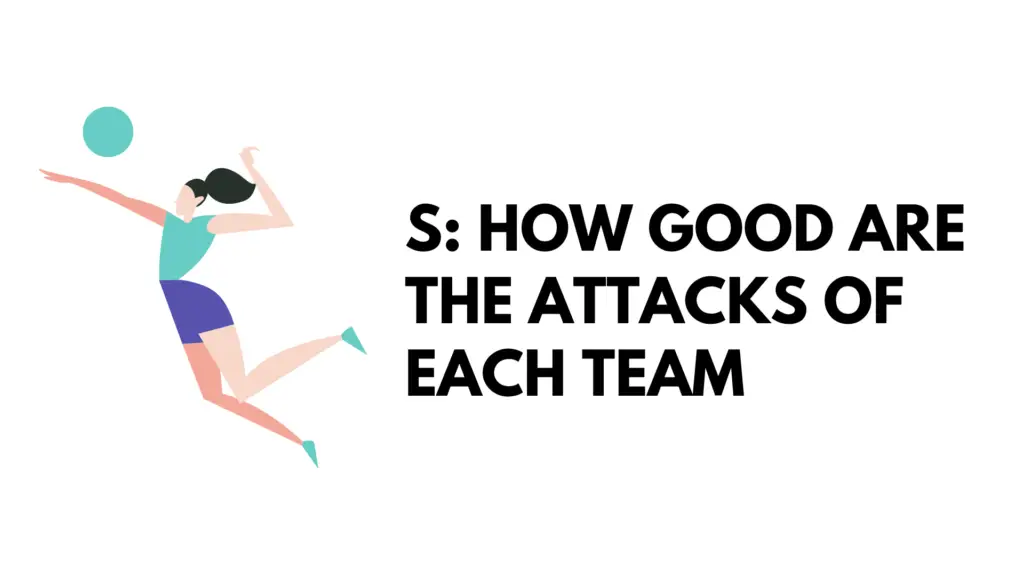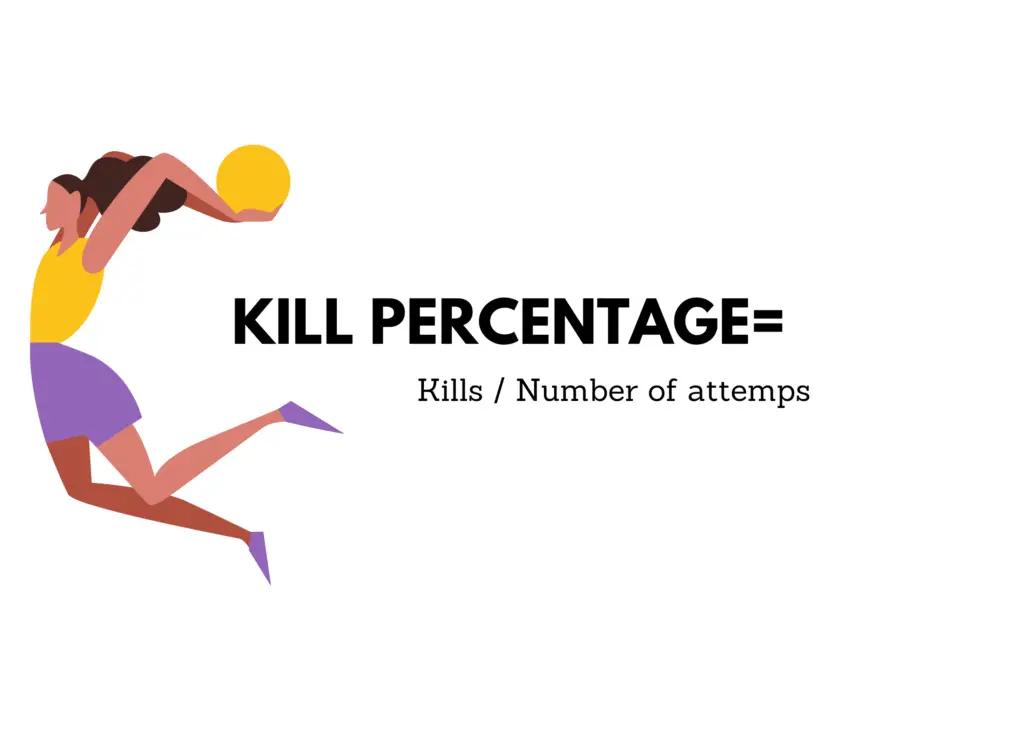During every official match, there are one or two people who write down a lot of statistics. They use forms that are provided by the organizer of the competition to make it simple. These forms are collected by the referee so that they can be used by the organizer of the competition.

This avoids discussions afterward and makes sure that everyone agrees about what happened. In most instances, the coaches have to sign this document so that there are no disputes later on.
This sheet is divided into different sections that we are going to discuss now.
1/ What is a s in volleyball?
The meaning of a s is attack statistics. This is a list of statistics that focus on the offense of a team (including kills, errors, and total attempts). This means that it is recorded when a team has pushed the ball over the net, be it with a spike, tip, set, or hit.

The result is a scored point (a kill) or a failed attack (error). An error is when the ball hits the net, goes out of bounds, or when the other team can recoup the ball. This makes it possible to see how efficient the attack was. If a team scores less than 40% of its attacks, it might indicate that they have some work to do in this aspect of its game.
To win a volleyball match, you need to be great at offense and defense. A lot of teams focus on one thing. Statistics can help the coach to see what needs to be worked on. There are also apps that help the coach to record these statistics during friendly games.
Especially at the beginning of the season, this is useful as it can give input on what drills need to be worked on. A lot of coaches use their feeling but statistics don’t lie and can help to provide deeper insights into what is going on. Maybe a player is out of position or a different strategy is needed to score more points.
2/ What does k mean in volleyball stats?
K stands for a kill in volleyball statistics. This means successful attacks whereby the ball hits the ground. This is often after a successful spike or tip. The opposite hitter or outside hitter often score these points and it can show how successful these players are. Every kill is a point that has been scored from the court (so excluding serves).

Professional teams play very fast and in some instances, they can score points in rapid succession if the defense of the other team is breaking down. If the defense is working really well, it is possible that there are long rallies during which the ball keeps going back and forth for a long period of time.
3/ What does k/s mean in volleyball stats?
This is the number of kills (k) or scored points divided by the number of attacks (s) or how many times the ball has been over the net. This provides an indication of how efficient the attack is of a team. This excludes serves as these are measured in a different way as this is not part of the court action.

If the team needs to push the ball over the net often before they score a point, it can indicate that the team needs to improve its attack. It is possible that the outside hitter or opposite hitter is not doing their job properly and needs to be substituted. Everyone can have a bad day and the coach often looks at these percentages to make decisions. This is also called the kill percentage.
Being able to have a ratio that is over 0.4 is essential as this means that about 4 out of every 10 attacks result in points. A spike is often easy to score if the defense is weak. Even if you have to deal with double or triple blocks, it should still be possible to score points from time to time if you have received a good pass from the setter.
4/ What does ta mean in volleyball stats?
The meaning of ta is total attempts. This means the total of attacks (kills, errors and 0 attacks). This is a part of attack statistics and can show how active the offense of a team has been. This excludes pushing the ball over the net for the sole reason of avoiding a four-hit violation.

A team that has a lot of attempts but not a lot of points has an offensive problem. You need to be efficient and score points when you can. Some teams don’t have the ability to finish an attack and despite being able to attack often are not able to win matches.
This can indicate that the hitters need to do a better job and become more efficient. Therefore having a lot of attempts is not enough. You need to be able to convert them into points as well.
5/ What is be in volleyball stats?
Be is a blocking error. It is a defensive fault in which the other team scores a point because the defense made an error. In most instances, this is because they touched the net while trying to block. Often it is the middle blocker that misjudged his or her block and jumped at the wrong moment. Blocking is not easy and even professionals make mistakes here.
This shouldn’t happen too often though as you are giving away points to the other team. It is an unforced error as it can be avoided in most instances. If it happens too often, the players have to work on their technique. You can hold your hands over the net when blocking but you have to make sure that you don’t touch it. This means that you have to move your arms and hands quite fast.
6/ What is bha on a volleyball statistics sheet?
Bha means ball-handling attempts. This is the total time that the team tried to touch the ball. Every team is only allowed to touch the ball a maximum of three times per attack. It can show how often a team needs to touch the ball before they attack.
It can also indicate that the team makes mistakes and touches the ball too often. This is mainly important for the newer teams as they might struggle with ball control. Professional players often are able to control the ball without too much effort as they have trained in these skills over and over again.
7/ What is sp in volleyball stats: what does sp mean?
Sp is sets played. This indicates how many sets were played in a match. This can be three or five sets. This is always an uneven number so that one team wins the match. Each set consists of points. Women play three sets while men play five sets.
Men play sets of 25 points, with the final set consisting of 15 points. If the teams are having the same score, they keep playing until one team wins the set with at least 2 points more than the other team. This can lead to long and exciting rallies.

If you are playing in a tournament and need a lot of sets to win a game, it can be quite tiring. Therefore efficient teams that need fewer sets to win, have an advantage as they have to spend less energy on trying to win a game. Some tournaments last only one day and if you have to waste a lot of energy in the first few games, it can be hard to win the finals.
8/ What does d/m mean in volleyball stats?
Dig stands for digs and m stands for a match. This statistic indicates the digs per match. This can provide the libero with input about how active he or she has been during the match. A dig is a ball that has been recovered after the other team has attacked.
This is often done by an underhand pass and the libero might have to dive to keep the ball in the air. This can lead to spectacular images as digging can be quite difficult.
Volleyball is a fast-paced game and it is possible that the libero has to make more than a hundred digs per match, depending on the level of the game and how well the other team attacks.
If possible, the attacking team should send the ball in another direction so that they can target players that are worse at digging than the libero. If the libero is tired, it is also possible that their digs are getting worse.
To conclude we can state that we discussed the different volleyball statistics in this post. These are recorded on a sheet so that both teams agree on what happened and there is no discussion afterward.
When a competition is really tight, tempers can start to flare and this objective document makes sure that there is no discussion about how many points were scored, who won, and so on. They can also be useful for players and coaches as it shows what they are doing well and what could be improved upon.